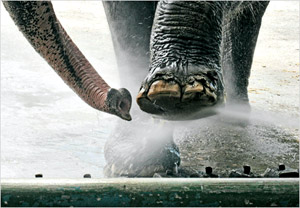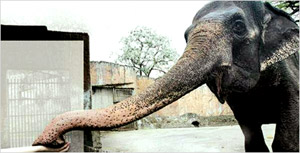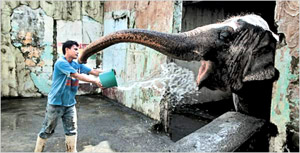NEVER HEARD AFTER SHE LEFT HERD
Tharindu Muthukumarana

I have been following the plight of Mali for months and today I am
glad that it has reached the eye of Sri Lankans. Mali is a Sri Lankan
elephant who was gifted to Manila zoo in Philippines in 1977. Today, in
the zoo, Mali is undergoing a stressful life affected physiologically as
well as psychologically. However according to PETA (People for the
Ethical Treatment of Animals), which is the world's largest animal right
activist group, Manila Zoo has about 72 square yards (60 square meters)
with a cement enclosure given for Mali to roam. Thirty-eight year old
Mali is the only elephant in Manila zoo, the only elephant in
Philippines too.
Isolation
Elephant's family units could be considered as tight-knit both
socially and structurally. Herds move and function in a cooperative and
coordinated manner. Mali is a female elephant. Wild females, born into a
family, stay in the family rest of their lives. Males, on the other
hand, leave the family shortly after reaching sexual maturity and have a
solitary life. The female elephants learn that their future could be
mothering, leadership, integration into and being a useful member of the
existing society. Each social society is made up of an intricate network
of relationships and a process of interactions with other members, the
mechanisms of which must be learned. Therefore, the loss of its family
or social bond network in Pinnawala and the isolation at present must be
a traumatic experience for Mali.
|

Mali in her “room” |
|

Look at my nails! |
Mali is said to be suffering from stereotype behaviour at present.
Stereotypes are defined as repetitive invariant behavioural patterns
that have no obvious goal and function or no purposeful behaviours.
Stereotypical behaviours are a clear indication that an elephant is
suffering. A restriction in behavioural complexity and deprivation of
social and emotional requisites can be experienced as stressful and
frustrating, resulting in atypical behaviour patterns such as
stereotypy. In elephants, stereotypes have been described as intentions
to stepping forward and backward and accompanied by rhythmical body and
trunk swaying, either in a forward-backward movement or sideways while
the animal is standing on the spot, accompanied by head-nodding and
often by trunk-swinging. These stereotypes are known as weaving also
this behaviour pattern can be mainly the result of chaining the animal.
Next to weaving, other forms of stereotype behaviour are also known
among elephants. In certain zoos, elephants walk stereotype laps and
elephants kept in narrow pens develop complex stereotype series of
fore-steps, side steps and back-steps.
According to Dr. Fred Kurt (Member of the Asian Elephant Specialist
Group of IUCN) circus people sometimes state that weaving is essential
for blood circulation - rather an extraordinary conjecture. But none of
the numerous studies on wild elephants weaving is mentioned, although
zoo speakers occasionally say that weaving occurs also under natural
conditions. He therefore describes that weaving is always associated
with intensive keeping systems, i.e. more or less permanent chaining in
small stalls, where living conditions deviate fundamentally from the
natural environment in which the animal's behavioural organisation has
been shaped by evolution. Normally in captive elephants that get lack of
proper treatment, toenails of the elephant are likely to break, split
and fall off. Without treatment, such conditions will damage the
animal's general health. Movement becomes difficult and it is possible
the elephant will die. According to pictures, published by PETA, of poor
conditions of Mali's feet; I recognise Mali is in bad condition. One
picture shows that Mali was a victim of split toenails. Elephants that
spend much time on concrete floors and get poor nutrition or
malnutrition can suffer from split or broken nails.
|

Greeting the visitors |
Lack of care
Renowned veterinarian and elephant expert Dr. Melvyn Richardson
mentions that Mali is lacking veterinary care. He has also recognised
that Mali has chronic pressure sores in both hips and both sides of her
face. These areas can become infected and become chronic abscesses.
After observing the video footages by PETA Dr Richardson mentioned that
Mali perhaps can be a victim of Osteoarthritis/Degenerative joint
disease (DJD) since in her behaviour she shifts her weight onto three
legs and rest one limb frequently. DJD may result from an imbalance of
the integrity of the joint and the extrinsic forces placed on it.
Typically there are mechanical insults that contribute to the
development of joint disease, but biological factors may also play a
role. Mechanical trauma due to repetitive loading stress on hard surface
is probably a major factor in the development of joint disease.
Mali's lack of sufficient exercise, excessive body weight and poor
conformation are other potential underlying factors conformation may
concentrate stress and mechanical failure may result in the joint. If
she is suffering in DJD, treatment for DJD should be a comprehensive
approach and include a variety of treatments and also an evaluation of
husbandry practices. Rest is essential after acute inflammation has
subsided. Moderate exercise will not have a deleterious effect on the
healing of cartilage. Exercise such as swimming, which seems to absent
in the Manila zoo, can be a good way for an animal to exercise while
weight bearing on the affected joint.
Socialised environments
|

In need of company |
Head of Manila's public Recreation and Parks Bureau Deogracias
Manimbo mentions that Mali will not get used to a different environment
after having being in Manila zoo. The problem is not whether Mali will
socialise or not. Elephants are animals that can get used to
environments. This fact has been proven before - elephants from
captivity have been introduced to social natural elephant environments
and it has been a great success. PETA looks forward to seeing Mali to be
transferred to Boon Lott's Elephant Sanctuary (BLES) in Thailand, which
has been a world-renowned elephant rehabilitation centre. This
sanctuary's goal is to rescue and protect the elephants from abuse and
ultimate extinction by breeding. Elephants in BLES interact in a natural
environment and even let people come and see. BLES has already offered a
place for Mali as soon as the Filipino government agrees on her release.
My opinion is it will be all right to have elephant in ‘captivity’, but
provided they are given adequate and proper treatment. Researchers will
find it easier to study the elephants that way. Elephants, such as Mali,
must be transferred to a better place with immediate action.
|

Mali gets a bucket of water from Noel Co, who has been her
caretaker at the Manila zoo for about 12 years |
(Writer is admin of the facebook page ‘Sri Lankans for Mali'.
https://www.facebook.com/pages/Sri-Lankans-For-Mali/448365708567649)
|





